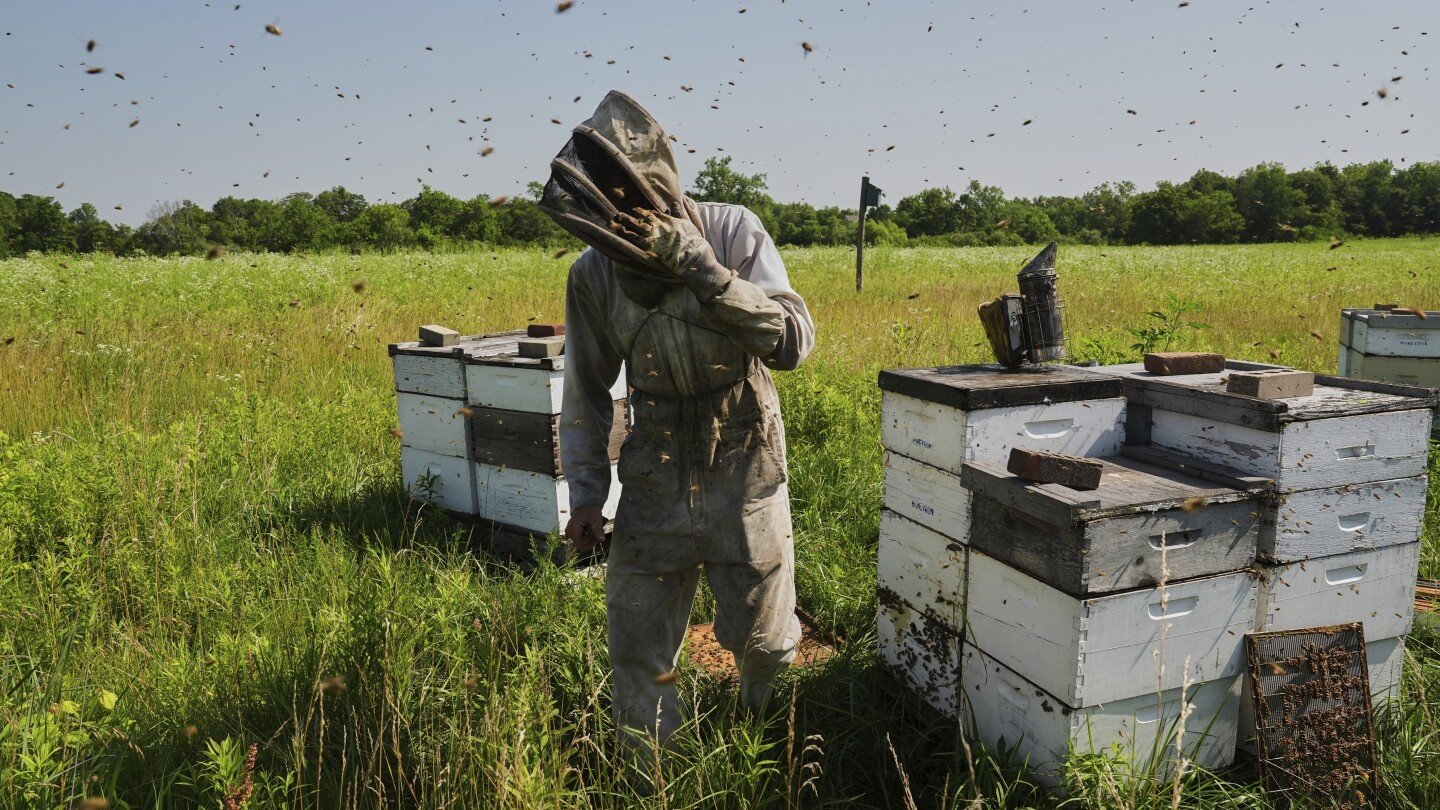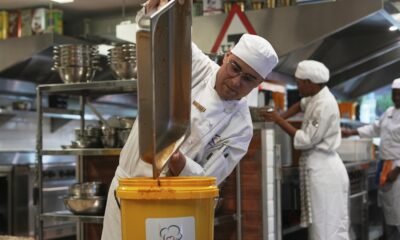Lifestyle
On a warming planet, scientists eager to learn more about how bees cope

WILLIAMSPORT, Ohio (AP) — Sweat covers Isaac Barnes’s face under his beekeeper’s veil as he hauls boxes of honeycomb from his hives to his truck. It’s a workout in what feels like a sauna as the late-morning June temperatures rise.
Though Barnes was hot, his bees were even hotter. Their body temperatures can be up to 27 degrees Fahrenheit (about 15 Celsius) higher than the air around them. As global temperatures rise under climate change, scientists are trying to better understand the effects on managed and wild bees as they pollinate crops, gather nectar, make honey and reproduce.
Isaac Barnes inspects a honeycomb from one of his honeybee hives Tuesday, June 24, 2025, in Williamsport, Ohio. (AP Photo/Joshua A. Bickel)
Isaac Barnes takes a drink of water after harvesting honeycomb from his honeybee hives Tuesday, June 24, 2025, in Williamsport, Ohio. (AP Photo/Joshua A. Bickel)
They noticed flying bees gathering nectar avoided overheating on the hottest days by using fewer but harder wingbeats to keep their body temperature below dangerous levels, according to a study published last year. Scientists also say that bees — like people — may also cope by retreating to a cooler environment such as the shade or their nest.
“Just like we go into the shade, or we sweat or we might work less hard, bees actually do the exact same thing so they can avoid the heat,” said Jon Harrison, an environmental physiologist at Arizona State University and one of the study’s authors.
But that means the bees aren’t able to do what they normally do, said Kevin McCluney, a biology professor at Bowling Green State University.
“They’re not going out and getting more nectar. They’re not mating. They’re not doing the things that bees would otherwise do,” McCluney said.
Heat is just one challenge for critical pollinator
Kevin McCluney, a biology professor, looks for bees to collect Tuesday, June 17, 2025, at Bowling Green State University in Bowling Green, Ohio. (AP Photo/Joshua A. Bickel)
Generally, most bees are heat-tolerant, but as the climate warms, some experts think their ability to fend off disease and gather food might become harder. And habitat loss, increased use of pesticides, diseases and lack of forage for both managed and wild bees are all listed as potential contributors to the global decline of bees and other pollinators.
“If you’re not well-fed, and your body is intoxicated with pesticides and you have lots of diseases in your body, you’re going to be less heat-tolerant than if you were healthy,” said Margarita López-Uribe, a pollinator health expert at Pennsylvania State University.
Scientists have found that bees may cope with heat the same way humans do — by finding a cooler environment. But they aren’t able to do as much as they normally do, and scientists worry that heat makes the bees more vulnerable to disease and plant diversity could decline due to less pollination. (AP Video: Joshua A. Bickel)
Earlier this year, preliminary results from the annual U.S. Beekeeping Survey found that beekeepers lost almost 56% of their managed colonies, the highest loss since the survey started in 2010.
Almost all of the managed honeybee colonies in the U.S. are used to pollinate agricultural crops such as almonds, apples, cherries and blueberries. Fewer pollinators can lead to less pollination and potentially lower yields.
“It’s a very fragile system if you think about it,” López-Uribe said. “Because if something goes wrong, you have these super high-value crops that won’t get enough bees for pollination.”
Losing hives at Honeyrun Farms
Back at Barnes’ hives in Ohio, thousands of honeybees fly around as he gathers boxes to take back to his farm for honey production. Nearby, a couple of his bees land on milkweed flowers, a rare bit of plant diversity in an area dominated by corn and soybean fields.
For Barnes, who operates Honeyrun Farm with his wife, Jayne, one of the challenges heat can pose to his 500 honeybee hives is fending off parasitic mites that threaten the bees. If temperatures get too hot, he can’t apply formic acid, an organic chemical that kills the mites. If it’s applied when it’s too hot, the bees could die.
As global temperatures rise under climate change, bees that pollinate many crops are under increasing stress. For Ohio beekeeper Isaac Barnes, heat can affect his bee colonies’ health into the winter just before crop pollination begins. In the U.S., beekeepers lost just over half of their colonies in the last year. (AP Video: Joshua A. Bickel)
Last year they lost almost a third of the 400 hives they sent to California to help pollinate commercial almond groves. Barnes thinks those hives may have been in poor health ahead of pollination because they were unable to ward off mites when it was hot months earlier.
“Dead hives aren’t pollinating the almonds,” he said. “It’s a real ripple effect that stems back from the heat in the summertime.”
Sometimes the heat helps. Here in Ohio, Barnes’ hives last summer produced a bumper crop of honey as they feasted on nearby soybean nectar as the plants bloomed in the heat. Still, the lack of diverse plants for bees to forage in an area dominated by corn and soybean fields isn’t ideal.
An employee scrapes raw honey off of a honeycomb while working Tuesday, June 24, 2025, at Honeyrun Farm in Williamsport, Ohio. (AP Photo/Joshua A. Bickel)
And even the native blooms are appearing erratically, Barnes said. In autumn, his bees search for food on goldenrod, but those blooms are appearing later. And even then, he has supplemented his hive with additional food to keep them healthy into the winter.
“Every single plant that blooms is something that the bee can use,” Barnes said. “And every single plant is affected by climate change.”
Research that may aid bees is in peril
It’s only in the last decade that people have become aware of the magnitude of the pollinator decline globally, said Harrison, of Arizona State University. Data is limited on how much climate change and heat stress is contributing to pollinator decline.
“It’s a relatively new focus for biology,” he said. “I think it’s super important, but it’s not being studied a ton.”
Reese Jackson holds a leafcutter bee inside of a collection vial Tuesday, June 17, 2025, at Bowling Greene State University in Bowling Green, Ohio. (AP Photo/Joshua A. Bickel)
The Trump administration’s proposed budget would eliminate the research program that funds the USGS Bee Lab, which supports the inventory, monitoring and natural history of the nation’s wild bees. Other grants for bee research are also in jeopardy.
U.S. Sen. Jeff Merkley of Oregon said America’s pollinators are in “grave danger,” and he’ll fight for the federal funding. Pollinators contribute to the health of the planet, the crops we grow and the food we eat, he said.
“Rather than taking bold action to protect them, the Trump administration has proposed a reckless budget that would zero out funding for critical research aimed at saving important pollinators,” he said in a statement to The Associated Press.
A bee-shaped sticker sits on a truck window Tuesday, June 24, 2025, in Williamsport, Ohio. (AP Photo/Joshua A. Bickel)
Harrison said his research on this topic would come to a halt if cuts are made to his federal funding, and it would be more difficult in general for scientists to study the disappearance of bees and other pollinators and improve how they prevent these losses. Not being able to manage these pollinator deaths could cause the price of fruits, vegetables, nuts, coffee and chocolate to jump or become scarce.
“Hopefully, even if such research is defunded in the U.S., such research will continue in Europe and China, preventing these extreme scenarios,” said Harrison.
___
The Associated Press’ climate and environmental coverage receives financial support from multiple private foundations. AP is solely responsible for all content. Find AP’s standards for working with philanthropies, a list of supporters and funded coverage areas at AP.org.
Lifestyle
What to know about sugar and high-fructose corn syrup in sodas

President Donald Trump teased the announcement last week, but the Coca-Cola Co. confirmed it Tuesday: a cane sugar-sweetened version of the beverage maker’s trademark soda will be released in the U.S. this fall.
For decades, Coke and the makers of other soft drinks have generally used high-fructose corn syrup or artificial sweeteners in their products manufactured in the U.S. But American consumers are increasingly looking for food and drinks with fewer and more natural ingredients, and beverage companies are responding.
PepsiCo and Dr Pepper have sold versions of their flagship sodas sweetened with cane sugar since 2009. Coca-Cola has sold Mexican Coke — which uses cane sugar — in the U.S. since 2005, but it’s positioned a trendy alternative and sold in glass bottles. Coke with cane sugar will likely be more widely available.
Here are some frequently asked questions about the sweeteners in U.S. sodas:
What’s the difference between cane sugar and high-fructose corn syrup?
Many consumers know that consuming too many sweets can negatively affect their health, but soda drinkers sometimes debate if either cane sugar or high-fructose corn syrup is better (or worse) than the other.
The short answer is that it doesn’t make a difference, said Marion Nestle, one of the nation’s top nutrition experts and professor emeritus at New York University.
High-fructose corn syrup is made of the simple sugars glucose and fructose in liquid form. Cane sugar, also known as sucrose, is made of glucose and fructose bonded, but quickly split, Nestle explained.
Both are still sugars, with about the same amount of calories.
Whether a can of Coca-Cola contains one or the other, it will still be a sugary drink with about the same amount of calories and the same potential to increase well-documented health problems from obesity and diabetes to tooth decay.
Why did soda companies switch from using sugar to high-fructose corn syrup?
High-fructose corn syrup costs less. According to price data from the U.S. Department of Agriculture, the wholesale price of HFCS-55, the type of corn syrup most commonly used in beverages, averaged 49.4 cents per pound last year. The average wholesale price of refined cane sugar was 60.1 cents per pound, while the average wholesale price of refined beet sugar was 51.7 cents per pound.
But high-fructose corn syrup has advantages beyond price. According to a 2008 paper in the American Journal of Clinical Nutrition, high-fructose corn syrup is more stable than sugar when added to acidic beverages, and it can be pumped directly from delivery trucks into storage and mixing tanks.
Why is high-fructose corn syrup less expensive that sugar?
Tariffs are one reason. The U.S. has had barriers on sugar imports almost back to its founding; the first went into place in 1789, according to the Cato Institute, a think tank that advocates free markets.
Since the passage of the Farm Bill in 1981, the U.S. has had a system in place that raises duties on sugar once a certain amount has been imported. The U.S. also has domestic production controls that limit supplies, keeping prices higher.
But high-fructose corn syrup is also cheaper because of the federal government’s billions of dollars in subsidies for corn farmers. Loans, direct payments, insurance premium subsidies and surplus crop purchases all lower farmers’ costs – and the price of the corn they grow.
Are sugar replacements used in diet sodas safe?
While cutting back on added sugars has documented benefits, replacing them with artificial sweeteners is complicated, too.
Coca-Cola Zero Sugar, introduced in 2017, uses the artificial sweetener aspartame and the natural sweetener stevia in its recipe.
But research suggests that aspartame may be linked to cancer. In 2023, a committee for the World Health Organization determined that aspartame should be categorized “as possibly carcinogenic to humans.”
While that doesn’t mean that diet soda causes cancer, the scientific committee concluded that there may be a possible link between aspartame and liver cancer, and that the issue should be studied further.
The U.S. Food and Drug administration disagreed with the WHO panel, citing “significant shortcomings” in the research that backed the conclusion.
FDA officials noted that aspartame is one of the most studied food additives and said “FDA scientists do not have safety concerns” when it is used under approved conditions.
Stevia, a plant-based sweetener, appears to be “a safe choice,” according to the Center for Science in the Public Interest, an advocacy group.
___
Durbin reported from Detroit. Aleccia reported from Los Angeles.
Lifestyle
The 700-year-old Prague cathedral will get a new voice as an organ is nearly installed

PRAGUE (AP) — The installation of a new organ at Prague’s St. Vitus Cathedral is nearing completion, giving the 700-year-old biggest temple in the Czech Republic a proper instrument to accompany religious services and concerts.
An international team was working on a three-story scaffolding above the main entrance inside the cathedral on Tuesday to put in place some of the remaining pipes. The work is scheduled to be complete in late August, followed by the voicing and tuning of the pipes through the end of the year.
The public could hear the organ’s first sounds on June 15 next year, the feast of St. Vitus, officials said.
The organ contains some 6,000 pipes, ranging in length 7 millimeters (0.28 inches) to 7 meters (23 feet).
The four-manual instrument was build in a workshop of Gerhard Grenzing in El Papiol near Barcelona in Spain. The renowned German organ builder has constructed almost 140 organs and reconstructed more than 90 historical instruments in many countries.
Once completed in Spain, the new organ was disassembled and its parts were gradually transported to Prague on trucks.
The cathedral is linked to the Czech statehood. It’s a place where the Czech kings were coronated and buried while the Czech crown jewels are stored inside.
The funeral Mass for Vaclav Havel, the Czech Republic’s first president, was celebrated in the cathedral on Dec 23, 2011.
The previous organ was completed in the early 1930s, but turned out to be too small for its monumental space and frequently broke down. There was no interest in fixing the organ during World War II and more than 40 years of communist rule.
Effort to build a new organ started in 2017, with a crowdfunding campaign that collected more than 109 million Czech koruna, or crowns, ($5.2 million), about 98% of the sum needed.
Lifestyle
Photos show a Filipino couple walking down a flooded aisle on their wedding day

MALOLOS, Philippines (AP) — Jade Rick Verdillo and Jamaica Aguilar were determined to walk down the aisle on their wedding day. Even if it meant walking down a flooded one.
On Tuesday, the Barasoain church in Malolos, Bulacan province, Philippines flooded due to heavy rain. Typhoon Whipa had intensified seasonal monsoon rains in the Philippines, bringing widespread flooding.
The couple anticipated the risk of flooding, but instead of letting the weather dampen the mood, they decided to push through, as all marriages have their challenges.
“We just mustered enough courage,” said Verdillo. “We decided today because it is a sacrifice in itself. But there will more sacrifices if we don’t push through today.”
Aguilar waded down the aisle with her white dress and wedding train floating behind her through waters almost up to her knees. At the altar, Verdillo was waiting to receive her while wearing an embroidered shirt called a Barong Tagalog, worn during special occasions.
Bride Jamaica Agular walks down the aisle during her wedding at the flooded Barasoain church in Malolos, Bulacan province, Philippines on Tuesday, July 22, 2025. (AP Photo/Aaron Favila)
Jade Rick Verdillo right, and Jamaica sit for their wedding ceremony at the flooded Barasoain church in Malolos, Bulacan province, Philippines on Tuesday, July 22, 2025. (AP Photo/Aaron Favila)
A wedding guest holds a flower during a wedding at the flooded Barasoain church in Malolos, Bulacan province, Philippines on Tuesday, July 22, 2025. (AP Photo/Aaron Favila)
The newlyweds have been together for 10 years. The groom said, “I feel that challenges won’t be over. It’s just a test. This is just one of the struggles that we’ve overcome.”
Despite the turbulent weather, some family and friends made it to the wedding.
“You will see love prevailed because even against weather, storm, rains, floods, the wedding continued,” said Jiggo Santos, a wedding guest. “It’s an extraordinary wedding.”
Newlyweds Jade Rick Verdillo right, and Jamaica walk hand in hand during their wedding at the flooded Barasoain church in Malolos, Bulacan province, Philippines on Tuesday, July 22, 2025. (AP Photo/Aaron Favila)
Groomsmen and guests stand knee deep in floodwaters wearing the traditional barong tagalog at Barasoain church in Malolos, Bulacan province, Philippines on Tuesday, July 22, 2025. (AP Photo/Aaron Favila)
Bridemaids attend a wedding ceremony at the flooded Barasoain church in Malolos, Bulacan province, Philippines on Tuesday, July 22, 2025. (AP Photo/Aaron Favila)
Guests attend a wedding at the flooded Barasoain church in Malolos, Bulacan province, Philippines on Tuesday, July 22, 2025. (AP Photo/Aaron Favila)
Bride Jamaica Aguilar, left, arranges her gown beside barefoot groom Jade Rick Verdillo, second from right, during their wedding at the flooded Barasoain church in Malolos, Bulacan province, Philippines on Tuesday, July 22, 2025. (AP Photo/Aaron Favila)
Guests attend a wedding at the flooded Barasoain church in Malolos, Bulacan province, Philippines on Tuesday, July 22, 2025. (AP Photo/Aaron Favila)
Newlyweds Jade Rick Verdillo, center, and Jamaica pose with a kiss as guests cheer at the flooded Barasoain church in Malolos, Bulacan province, Philippines on Tuesday, July 22, 2025. (AP Photo/Aaron Favila)
-

 Europe5 days ago
Europe5 days agoKneecap, Massive Attack, Brian Eno among UK and Irish musicians banding together to speak out on Israel’s war in Gaza
-

 Sports5 days ago
Sports5 days agoFrom Tokyo to Citi Field: Kodai Senga is a key part of baseball’s international charge
-

 Europe5 days ago
Europe5 days agoAnalysis: China was on the sidelines of the Iran-Israel war. That’s just where it wanted to be
-

 Africa5 days ago
Africa5 days agoVoter turnout in Togo’s municipal elections overall low
-

 Africa4 days ago
Africa4 days agoAtlas Lionesses roar into Afcon semi-finals, sparking celebrations in Rabat
-

 Europe5 days ago
Europe5 days agoCrisps: How a greasy airbag of gratification became Britain’s national dish
-

 Lifestyle4 days ago
Lifestyle4 days agoSouth African cooks aim to stir up 67,000 liters of soup to fight hunger on Mandela Day
-

 Asia4 days ago
Asia4 days agoForced from Bhutan, deported by the US: these stateless Himalayan people are in a unique limbo




